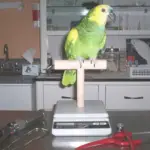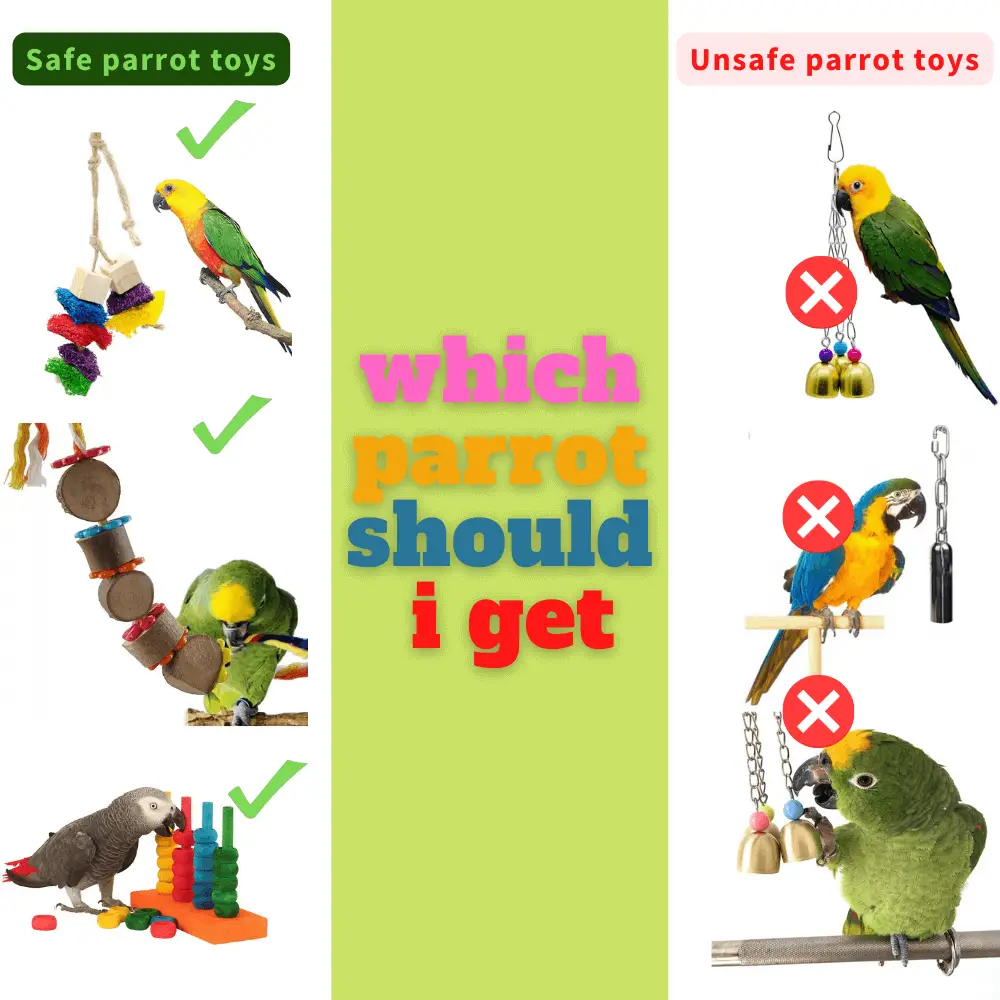
Unsafe bird toys: Before offering a toy with metal parts to your parrot, make sure that it do not contain zinc ( zinc plated or galvanized ).
This metal is highly toxic to parrots. Although rumor has it that we can “clean” these metals with vinegar to make them safe, it is not. VINEGAR CLEANING DOES NOT NEUTRALIZE ZINC! Whether it is the metal pins of a cage or in certain pieces of hardware.

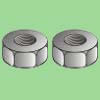
Galvanizing is a very economical method of protecting metal from rust by dipping it in molten zinc ( zinc-plated steel is the cheapest of the steels ).
Vinegar cleaning only serves to remove the fine powder that forms on the surface ( excessively toxic ) without damaging the layer of zinc which acts as a protection for the metal. In any case, acidic environments such as vinegar neutralize zinc.
So which metals to use?
Stainless steel is the best choice when metal parts must be used in the making of a parrot toy, but it is very expensive ( it is the most expensive of the steel).
To check if the part is really stainless steel, pass a magnet over it, if the part does not adhere to it, it is stainless steel. You can also use nickel-plated hardware ( steel is less expensive than stainless steel, but much more expensive than zinc plated, a good compromise, it is safe ). Nickel-plated steels are generally NP ( nickel-plated ) stamped.

Unimaginably dangerous
Most of the time, a manufacturer who uses stainless steel or nickel-plated parts will indicate this on their packaging or advertise it.
These are much more expensive materials than zinc plated ones; therefore, the price of toys to the consumer is necessarily affected.
As the parrot toy industry is booming and very competitive, it is often the price displayed on pet store displays that will weigh in on the customer’s choices…
This is a big mistake… more c inexpensive, the lower the quality of the materials… the same equation in many areas, the pet accessories market is no exception to the rule …To be completely avoided
There is also a multitude of copies and/or counterfeits that are manufactured on the Asian continent (even for North American brands) at this time. Better to prefer the original, even if it is a little more expensive.
Also avoid chains or carabiners plated with anything ( copper, brass, etc. ) when it comes to toys for your parrot.

Unsafe bird toys
Chains
Avoid metal chains that bend a bit too easily in your hands. Often they contain lead in the composition of the metal. The chains that go into the manufacture of toys for parrots must absolutely have welded links so that the parrot does not manage to open them and thus transform them into hooks for careless beaks. Jack chain-style chains are terribly dangerous for parrots.
Metal chains are preferably stainless steel or if your budget is tight, nickel-plated. You should absolutely avoid chains plated with zinc ( highly toxic to parrots ).
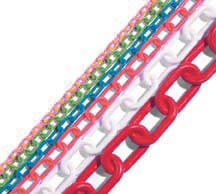
Unsafe bird toys
Prevent toe traps: the links of metal or plastic chains should be either very large so that the parrot can pass through them and easily remove a toe, or be very small so that the parrot does not pass its toe.
If you live with a very energetic, wiggly parrot, you should definitely avoid toys that have very long hanging chains without any other material on them ( wood, beads, rope, etc. ).
Some spirited parrots are likely to wrap the chain around the body or worse, around the neck and hang or strangle themselves. The chains must be removed or re-threaded as soon as they begin to uncover their fittings
To avoid absolutely: the long, very thin ( delicate ) chains which are formidable for both small and large parrots.

Toxic
+ non-welded paints or veneers
Fixings
It is important that the fastener is not used to impale the parrot’s beak and that it is large enough that no small part will come loose ( and risk being swallowed by the bird ).
The parrot is really a “digger”. If he feels a small weakness in an object, he will immediately try to open it, move it away, or separate it; which often will transform the attachment or ironwork into a hook for the parrot’s beak.
Quick C-link carabiner
( quick link or Clink )
This is about the only fastener ( tether ) that is roughly safe for the large inquisitive beaks of parrots. For smaller parrots such as the lovebird, budgerigar, small conure, or cockatiel, the pear-shaped carabiner ( pear link ) is also safe but it remains very dangerous for larger birds.
Keyrings
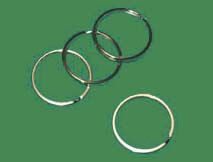
Keyring rings =
guaranteed injury
Beaks impaled, toes caught, twisted, or broken, are the consequences of this type of attachment. Parrots like to explore anything that comes under their beak. They will therefore automatically try to open and remove the ring in question and risk injuring it very seriously.
At this point, this kind of ring looks like a hook with a parrot’s beak. It is the most dangerous of the parrot toy fasteners and unfortunately one of the most used.
“S” chains

Never an
“S” tie
Too often responsible for impaled beaks or stuck, twisted, or broken toes in parrots. Avoid any toy company that uses these kinds of ties. They are not serious companies.
Various carabiners
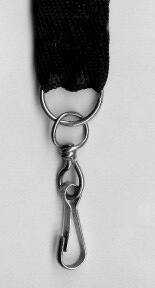
Unsafe bird toys
To be completely banned: all carabiners designed for dog leashes ( snap hooks ), boats, ropes, etc., as well as all other pressure “fasteners” which close or become wedged by themselves.
Always think in terms of the bird’s safety and always ask yourself if it is possible for it to insert its beak or toe into it. Prevention is better than cure.
Hardware store

Dangerous
It is important to measure the dangerous content of the hardware stores that you spot on a commercial toy or on a toy that you want to make yourself. Screws, nails, studs, staples, welded or non-welded eyelets, etc. are to be completely prohibited in a toy, playpen, or parrot swing. These are materials that easily break down and are therefore dangerous.
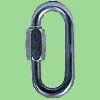
Rings and loops should be large enough for the parrot to fit its entire body through, or small enough so that the bird cannot stick its head or get a toe or paw through it. Either way, the less hardware on a toy, the better!

Toxic and dangerous
If you need to hang a perch or toy from the ceiling, do not use decorative hanging lamp hooks. First, they often contain lead or other toxic metals and paints; of two, a medium or a large parrot will inevitably succeed in unhooking the suspended toy and will be taken in the position of the separation, that is to say, one paw hanging from the ceiling on the hook and the other holding the perch or the toy in a vacuum. Very uncomfortable and insecure as a posture.
Better to use a welded eyelet ( nickel-plated ) that you will fix to the ceiling. Thus, the parrot will not be able to unhook anything and its toy or perch will remain securely in place, where it should be.
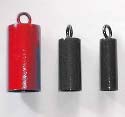
Unsafe bird toys
The bells
The bells of parrot toys must be welded together or inaccessible ( except in the case of very small parrots ). The parrot being curious by nature will inevitably attack the clapper and risk ingesting it if it succeeds in unhooking it and/or impaling its beak on the small hook inside which is used to fix the clapper. There are no bells on the market designed specifically for parrots. They are also noisy, but less dangerous.
 Unsafe bird toys
Unsafe bird toys
Finger traps + toxic
Round bells ( bells ) are to be totally avoided ( for all sizes of parrots ). These are toe and beak traps for parrots. Due to the shape of the slits, it is easy for a parrot to insert a toe in the wide part and slide it towards the thin part, which causes constriction of the toe.
In addition, most of these bells are designed for garnishes or decorations with very cheap materials, of more than questionable quality. Excessively dangerous!
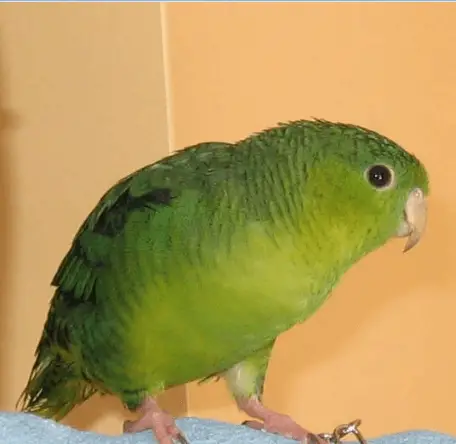
Unsafe bird toys
10 Dangerous Bird Products You Should NEVER Buy!
SOURCE: ElleAndTheBirds
Parrot safe toys
When buying games, the number one priority is security. Avoid toys with small parts that can be detached. Tighten hanging toys securely, and wet the rope or leather to make sure the knot is tight enough.
Other aspects to consider include:
Size: Toys should be sized to fit the size of the bird.
Bells: Bell spandrels should be securely attached.
Remove the eardrums if the bird is strong enough to remove them using a pair of pliers Large birds should never have access to small bells. Avoid old bells as they may be made of heavy metals such as
than lead or zinc.
Marbles: Plastic marbles are acceptable for small birds, but should not never be offered to large parrots. Offer logs for larger birds in place. Vegetable dyes should be used to color the beads. Recommended size of
beads:
Leather: Raw leather and leather in play must be genuine.. Dyes used to color leather can be toxic. choose leather untanned or vegetable-tanned leather.
Chains: Chains should have smooth welds. Links should be large enough to prevent a toe from slipping stuck up.
Rope: Always use natural fibers (plastic and synthetic fibers can cause significant injury if ingested or rolled up
around the toes or limbs) Check the rope frequently and remove it when it becomes soiled or worn If strands of rope unravel,
they can become tangled between the toes (a regular claw pruning will minimize this risk) Also watch your bird make sure it does not ingest pieces of rope. Check fasteners or connectors carefully
Attachments: Can the bird’s beak or toes get stuck? A clamp-type connector is only safe for small birds. Most birds require a quick connector (such as that used for key rings, circular)
Clamps should be used for large birds.
“Dog leash” carabiners or rings for shower curtains can be dangerous. Birds like to chew and many toys will be destroyed. It’s a good thing! This is one of the goals sought with bird games.
Since the work of birds is to destroy their toys, it is recommended to inspect them daily. Also supervise your bird when it plays with its games, especially when new. Finally, not all birds interact with their games and the ability to play may be
learned to some extent.

